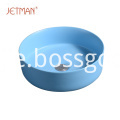Recently, researchers Liu Jinhuai and Huang Xingjiu of the Institute of Intelligence, Hefei Research Institute of the Chinese Academy of Sciences led the research team and made important progress in the research of nano-gap electrode sensor devices. The outstanding feature of the nano-gap electrode sensor device is that it can directly convert a certain characteristic of the substance to be measured into a more concise and more intuitive electrical signal-such as resistance, impedance, etc., to achieve trace, high-sensitivity detection of target molecules . Among them, how to obtain enhanced and effective signals for trace target molecules has always been one of the research hotspots. Researchers of the Institute of Intelligence used gold nanoparticles to construct nanogap electrodes, and proposed two new detection ideas. First, they introduced cadmium selenide quantum dots between the nano-gap electrodes to effectively improve the sensitivity and signal strength of the organic molecule streptavidin detection. At the same time, they used electrochemical impedance spectroscopy and cyclic voltammetry to further confirm the significant signal enhancement effect under ultraviolet and visible light; after stopping the light, the electrochemical impedance value returned to the level without light. These findings indicate that the signal enhancement of cadmium selenide quantum dots is reliable and reversible. The research result was recently published in the International Nanomaterials Magazine "Microscale" and was selected as the current cover. On the contrary, the researchers assembled cyclodextrin onto the surface of gold nanoparticles and used the trapping effect of cyclodextrin molecule (CD) cavity on polychlorinated biphenyl molecules (PCBs) to propose another "inhibition of charge transport" formula. A new method of detection, that is, when PCB molecules with poor dielectric properties enter the cavity of the cyclodextrin molecule, the measured current signal intensity shows a significant decrease. Using this method, the lowest detection concentration of PCB can reach 1 nanometer. This result was published in the "Analytical Chemistry" magazine of the American Chemical Society. It is reported that the above-mentioned research work has received support from the national "973" plan project, the National Natural Science Foundation of China's major research plan "basic research in nano-manufacturing", and the "100-person plan" of the Chinese Academy of Sciences. Just like people, basins also need to display its individuality into the public eye, so Color Basin was born because of demand. Main colors we have in production normally includes matte white, green, pink, matte black, gray, orange and blue. Generally speaking, there are two kinds of spray like painting and decal. Choose what you need, like what you pick, JETMAN is your wise choice. Color Basin Art Basin,Artistic Basin,Vanity Cabinet,Art Wash Basin GUANGDONG ZHIJIE SANITARY WARE CO., LTD. , https://www.zhijiesanitary.com Art round lavatory art blue Basin ceramic
Art round lavatory art blue Basin ceramic